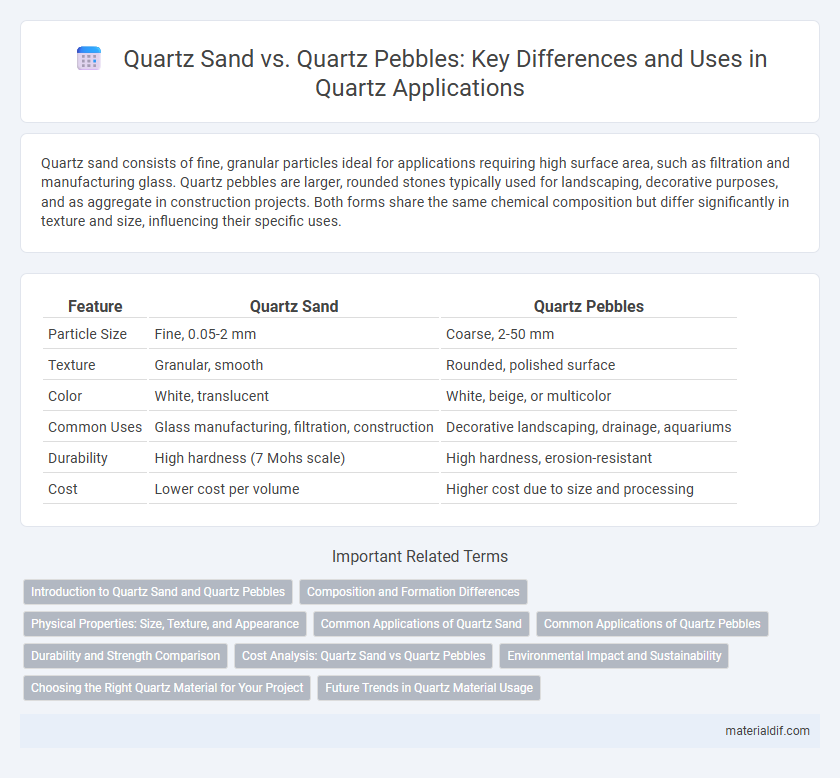Quartz sand consists of fine, granular particles ideal for applications requiring high surface area, such as filtration and manufacturing glass. Quartz pebbles are larger, rounded stones typically used for landscaping, decorative purposes, and as aggregate in construction projects. Both forms share the same chemical composition but differ significantly in texture and size, influencing their specific uses.
Table of Comparison
| Feature | Quartz Sand | Quartz Pebbles |
|---|---|---|
| Particle Size | Fine, 0.05-2 mm | Coarse, 2-50 mm |
| Texture | Granular, smooth | Rounded, polished surface |
| Color | White, translucent | White, beige, or multicolor |
| Common Uses | Glass manufacturing, filtration, construction | Decorative landscaping, drainage, aquariums |
| Durability | High hardness (7 Mohs scale) | High hardness, erosion-resistant |
| Cost | Lower cost per volume | Higher cost due to size and processing |
Introduction to Quartz Sand and Quartz Pebbles
Quartz sand consists of finely ground particles of quartz, primarily used in industrial applications such as glassmaking, foundries, and filtration due to its high silica content and uniform grain size. Quartz pebbles are naturally rounded, larger grains of quartz commonly employed in landscaping, decorative features, and construction for their aesthetic appeal and durability. Both materials originate from quartz but differ significantly in size, texture, and typical application sectors.
Composition and Formation Differences
Quartz sand consists primarily of fine, angular grains of silicon dioxide (SiO2) formed by the weathering and erosion of quartz-rich rocks, resulting in a granular texture ideal for filtration and glassmaking. Quartz pebbles are larger, rounded fragments formed through prolonged water or wind transport, causing abrasion and smoothing of quartz crystals, which retain the same chemical composition but differ in physical morphology. These differences in composition and formation influence their industrial applications, with sand favored for its high purity and surface area, and pebbles valued for durability and aesthetic uses in landscaping.
Physical Properties: Size, Texture, and Appearance
Quartz sand consists of fine granules typically ranging from 0.0625 to 2 millimeters in diameter, characterized by its uniform, angular particles and a rough texture ideal for filtration and abrasive applications. Quartz pebbles are larger, generally between 2 and 64 millimeters, with smooth, rounded surfaces formed through natural weathering processes, offering superior aesthetic appeal for landscaping and decorative uses. Appearance-wise, quartz sand appears more granular and matte, whereas quartz pebbles exhibit a polished, glossy finish with varied color tones due to prolonged exposure to environmental elements.
Common Applications of Quartz Sand
Quartz sand is primarily used in industrial applications such as glass manufacturing, foundry molds, and hydraulic fracturing due to its high silica content and fine grain size. Its uniform particle size makes it ideal for producing durable glass products and providing structural support in fracturing operations. Unlike quartz pebbles, quarz sand is favored in construction and filtration systems for its consistency and purity.
Common Applications of Quartz Pebbles
Quartz pebbles are commonly used in landscaping, decorative garden pathways, and water features due to their smooth texture and aesthetic appeal. They also serve as effective drainage media in construction and civil engineering projects, enhancing water filtration and soil aeration. Their durability and natural appearance make quartz pebbles a preferred choice for aquarium substrates and interior decoration.
Durability and Strength Comparison
Quartz sand features fine, uniform grains known for high hardness and resistance to weathering, making it ideal for construction and filtration applications requiring consistent particle size. Quartz pebbles consist of larger, rounded particles that exhibit exceptional durability and mechanical strength, suitable for landscaping and heavy-duty industrial uses. Comparing durability, quartz pebbles withstand impact and abrasion better than quartz sand, while quartz sand offers superior flexibility and compaction in concrete mixtures.
Cost Analysis: Quartz Sand vs Quartz Pebbles
Quartz sand generally offers a lower cost per ton than quartz pebbles due to its finer granulation and more abundant availability in natural deposits. Quartz pebbles involve higher extraction and processing expenses, contributing to their elevated market prices, particularly when uniform size and shape are required for specialized applications. Budget considerations for construction, filtration, or landscaping projects often favor quartz sand for cost-efficiency without significant compromise on performance.
Environmental Impact and Sustainability
Quartz sand extraction typically results in higher environmental disruption due to extensive mining and habitat destruction, whereas quartz pebbles can often be sourced with less invasive methods like riverbed collection. Quartz pebbles, being naturally weathered and rounded, require less processing, reducing energy consumption and carbon emissions compared to crushed quartz sand. Sustainable management of both resources involves minimizing extraction footprints, promoting recycling, and implementing responsible sourcing practices to protect ecosystems and water quality.
Choosing the Right Quartz Material for Your Project
Quartz sand offers fine granularity ideal for precise applications like glass manufacturing and filtration systems, while quartz pebbles provide larger, more durable particles suited for landscaping and decorative purposes. Selecting the right quartz material depends on the project's functional requirements, such as particle size, strength, and aesthetic preferences. Consider the mechanical properties and end-use environment to ensure optimal performance and longevity.
Future Trends in Quartz Material Usage
Quartz sand is expected to dominate future industrial applications due to its fine particle size, high purity, and versatility in manufacturing processes like glass production, ceramics, and electronics. Quartz pebbles, valued for their larger size and natural durability, will see increased demand in landscaping, construction aggregate, and filtration media sectors. Innovations in sustainable extraction and processing methods will drive the growth and environmental efficiency of both quartz sand and quartz pebble utilization.
Quartz Sand vs Quartz Pebbles Infographic

 materialdif.com
materialdif.com